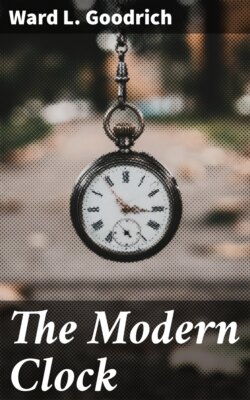Читать книгу The Modern Clock - Ward L. Goodrich - Страница 6
ОглавлениеFig. 10. Fig. 11.Fig. 12.
The lenticular pendulum bob has a diameter of 24 cm., and is made of red brass. The bob is supported at its center by the regulating nut, O, Figs. 10 and 12. That the bob may not turn on the cylindrical pendulum rod, the latter is provided with a longitudinal groove and working therein are the ends of two shoulder screws which are placed on the back of the bob above and below the regulating nut, O; and thus properly controlling its movements.
From the foregoing description the action of the compensation is readily explained. For the purpose of illustration of its action we will accept the fact that there has been a sudden rise in temperature. The steel rod, S, and the tube, R, will lengthen in a downward direction (including the suspension spring and the pendulum hook), conversely the aluminum tube, A, which is fastened to the steel rod at one end and the steel tube at the other, will lengthen in an upward direction and thus equalize the expansion of the tube, R, and rod, S.
As the coefficients of expansion of steel and aluminum are approximately at the ratio of 1:2.0313 we find that with such a pendulum construction—accurate calculations presumed—we shall have a complete and exact coincidence in its compensation; in other words, the center of oscillation of the pendulum will be under all conditions at the same distance from the bending point of the suspension spring.
This style of pendulum is made for astronomical clocks in Europe and is furnished in two qualities. In the best quality, the tubes, steel rod, and the bob are all separately and carefully tested as to their expansion, and their coefficients of expansion fully determined in a laboratory; the bushings, P and M, are jeweled, all parts being accurately and finely finished. In the second quality the pendulum is constructed on a general calculation and finished in a more simple manner without impairing its ultimate efficiency.
At the upper part of the steel tube, R, there is a funnel-shaped piece (omitted in the drawing) in which are placed small lead and aluminum balls for the final regulation of the pendulum without stopping it.
The regulation of this pendulum is effected in three ways:
1. The preliminary or coarse regulation by turning the regulating nut, O, and so raising or lowering the bob.
2. The finer regulation by turning the 100 grammes weight, g, having the shape of a nut and turning on the threaded part of the tube, R. 3. The precision regulation is effected by placing small lead or aluminum balls in a small funnel-shaped receptacle attached to the upper part of the tube, R, or by removing them therefrom.
It will readily be seen that this form of pendulum can be used with zinc or brass instead of aluminum, by altering the lengths of the inner rod and the compensating tube to suit the expansion of the metal it is decided to use; also that alterations in length may be made by screwing the bushings in or out, provided that the tube be long enough in the first place. After securing the right position the bushings should have pins driven into them through the tube, in order to prevent further shifting.
